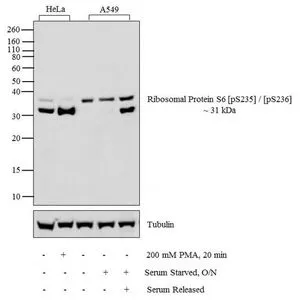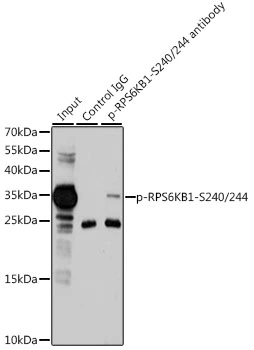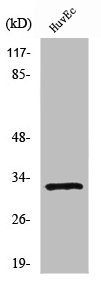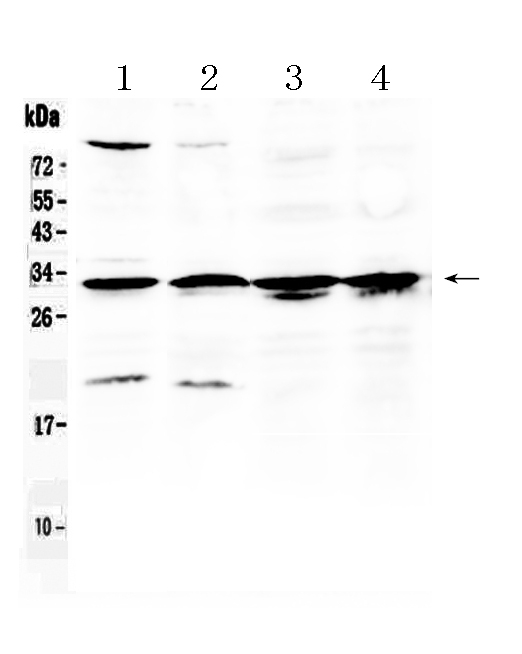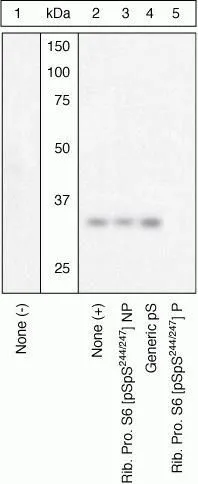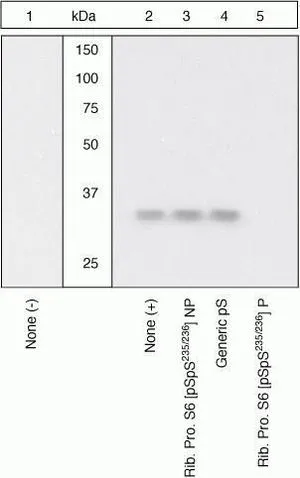
WB (peptide competition) analysis of HeLa cells treated with anisomycin (Lane 2-5) using GTX12864 RPS6 (phospho Ser235/236) antibody prior incubated with the non-phosphopeptide corresponding to the immunogen (Lane 3), a generic phosphoserine-containing peptide (Lane 4), or, the phosphopeptide immunogen (Lane 5) control. The data show that only the immunogen phosphopeptide blocks the signal, demonstrating the specificity of the antibody.
RPS6 (phospho Ser235/236) antibody
GTX12864
Overview
- SupplierGeneTex
- Product NameRPS6 (phospho Ser235/236) antibody - Orthogonal Validated
- Delivery Days Customer9
- Application Supplier NoteWB: 1:500. *Optimal dilutions/concentrations should be determined by the researcher.Not tested in other applications.
- ApplicationsWestern Blot
- CertificationResearch Use Only
- ClonalityPolyclonal
- ConjugateUnconjugated
- Gene ID6194
- Target nameRPS6
- Target descriptionribosomal protein S6
- Target synonyms40S ribosomal protein S6; phosphoprotein NP33; S6; small ribosomal subunit protein eS6
- HostRabbit
- IsotypeIgG
- Protein IDP62753
- Protein Name40S ribosomal protein S6
- Scientific DescriptionRibosomes, the organelles that catalyze protein synthesis, consist of a small 40S subunit and a large 60S subunit. Together these subunits are composed of 4 RNA species and approximately 80 structurally distinct proteins. This gene encodes a cytoplasmic ribosomal protein that is a component of the 40S subunit. The protein belongs to the S6E family of ribosomal proteins. It is the major substrate of protein kinases in the ribosome, with subsets of five C-terminal serine residues phosphorylated by different protein kinases. Phosphorylation is induced by a wide range of stimuli, including growth factors, tumor-promoting agents, and mitogens. Dephosphorylation occurs at growth arrest. The protein may contribute to the control of cell growth and proliferation through the selective translation of particular classes of mRNA. As is typical for genes encoding ribosomal proteins, there are multiple processed pseudogenes of this gene dispersed through the genome. [provided by RefSeq, Jul 2008]
- Storage Instruction-20°C or -80°C,2°C to 8°C
- UNSPSC12352203
References
- Activation of the mTOR pathway by low levels of xenoestrogens in breast epithelial cells from high-risk women. Goodson WH 3rd et al., 2011 Nov, CarcinogenesisRead more

